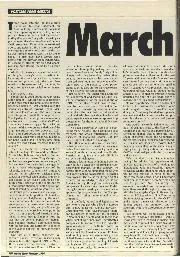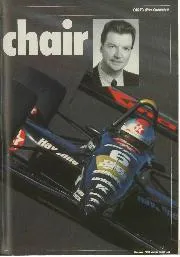

March chair
Three hours into the job it's a trifle premature to pass judgment on Andrew Craig, CART's next president and chief operating officer. Still, you only get one chance to make…
THE TRIUMPH ” GNAT “
An Economical Small Car with a Lively Perjormance.
THE tremendous increase in the popularity of the small sports car has been one of the most prominent features of motoring in the last few years. Its touring brethren have shown that the comparatively poor man can now take up motoring, without becoming insolvent as a result, and now it is proven in addition that the poor man can also motor with considerable speed and snappiness, without financial embarrassment.
The whole-hearted small car enthusiast will carry his argument still further, and will definitely state that something well under 1,000 c.c. will provide all the performance that anyone can want, so that the big car is entirely superfluous. When he reaches this stage it is time to mention gently that he has forgotten one or two points, and that people sometimes buy cars for reasons of accommodation, power at lower engine speeds, and even to exceed the admittedly fine performance of the “baby.” Nevertheless, there are thousands of actual and potential motorists to whom the small car has an irresistible appeal, not only on the score of hard cash, but by reason of the fascinating handiness of this type, enabling averages through traffic and over narrow and difficult roads which are unsafe or impossible on a larger vehicle.
A recent week end during which we had a Triumph ” Gnat ” at our disposal, enabled us to see even more vividly, why it is that the small car enthusiast is increasing in numbers.
There are many points about the Triumph chassis which have always appealed to us as being modelled on the best car design and practice. The whole job is extremely solidly constructed and neatly laid out. It is essentially a large car in miniature, and the finish is beyond reproach. It is built to the designer’s ideal of specification first, and to be sold at a low price as a secondary consideration.
A tireless ” revver.”
The chief feature of the engine is the fact that in spite of its small size it employs a 3-bearing crankshaft, and the result amply repays any extra cost that may have been incurred in so doing. Throughout its full range of speed (and 5,000 r.p.m. is nothing to worry about on this model), it is absolutely smooth, and in spite of the high engine speed inseparable from such a small unit, there is never any feeling that it is being overdriven or stressed in any way.
The top gear ratio of 6.25 means that the r.p.m. are very high indeed, as it is possible to hold 60 m.p.h. for miles on end when conditions allow, and a maximum speed of 65 m.p.h. is attained. Acceleration is good on top gear, and especially so on the second gear of 11.1 to 1, but we should have preferred the lower ratios to be rather closer to top, as this would improve the performance on hills, which good as it is, sometimes seems to be asking rather a lot from the engine when all out on second
gear. We must admit, however, that the engine does not appear to mind in the least how much it is revved, so the objection is not a serious one.
Solidity with Snappiness.
Handling on the road was good, and the robust chassis and normal layout of the springing assist to give it a very steady feeling at all speeds, which makes one imagine oneself to be at the wheel of a much larger vehicle. The steering was good on the straight and very steady, but though it was perfectly well-behaved on corners, there was not as much caster action as we should have liked, with the result that it was apt to feel just the least bit “dead.” The car itself was particularly free from any rolling on corners, although not built excessively low.
In fact the ground clearance has been kept by careful design at no less than 8′, which makes the car very suitable for trials work, especially in view of its low gears and ample power output of just over 23 h.p. at 4,000 r.p.m.
Some excursions over rough going with this particular car further confirmed the impression of strength which we got as soon as we took it over, and in spite of some rather abnormal banks and boulders attacked in the course of our wanderings we failed to ground anything.
The brakes are one of the outstanding features of this car, and are liable to take one quite by surprise at first. They are hydraulic, on the Lockheed principle, and although tremendously powerful are not fierce. They will bring the car to rest in 50ft. from a speed of 40 m.p.h., on a dry tarmac surface, which is a performance considerably above the average.
The bodywork is well finished, and comfortable, and the whole car possesses many attractions to the owner who wants a neat 2-seater, cheap to run, and with a performance which enables him to hold many much larger and most costly vehicles on the road, and to stand a good chance in competitions.